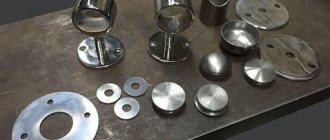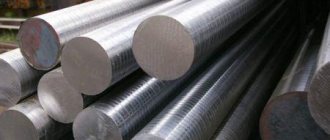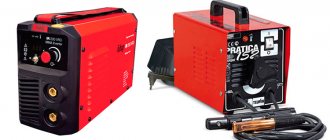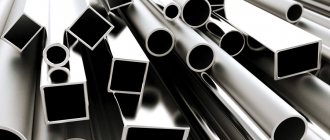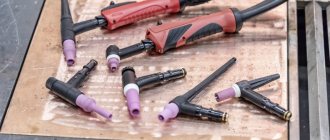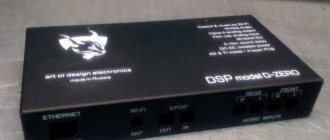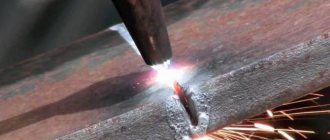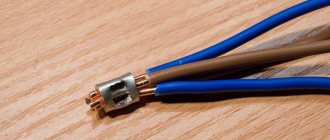Cast iron
Cast iron kitchen utensils have come to us from time immemorial. Today, many housewives prefer cast iron frying pans rather than more modern materials. And this is not surprising, such pans are ideal for products that need to be cooked for quite a long time. Cast iron heats up very strongly and quickly - just what you need for high-quality frying.
In addition, during the cooking process there is virtually no need to stir food. Cast iron is a porous metal, so a natural non-stick film of fat forms on the bottom and inner walls of such a frying pan. In this case, you don’t have to be afraid to use lemon juice or vinegar, since cast iron products are resistant to such acids. But you shouldn’t use detergents that “remove grease even in cold water” when caring for cast iron frying pans and other utensils made from this material. Cast iron dishes are not washed at all, but are calcined over a fire, after which they are rinsed under running cold water.
If we talk about the disadvantages of cast iron frying pans, there are several of them: the possibility of rust forming on its surface (as a result of improper care, long-term storage of cooked food, etc.), quite large weight, as well as fragility (if such a frying pan is for some reason falls on the floor for some reason, it can easily break).
Pros and cons of aluminum frying pans
The methods for making aluminum frying pans are similar - these are the stamping method and hollow casting. The second is more effective - due to the compacted layer of the bottom and sides.
Advantages of aluminum pans
1. Reasonable price. Aluminum cookware is just as functional as cast iron or steel, but much cheaper.
2. Light weight, but durable coating;
An aluminum frying pan is indispensable outdoors
3. The pans heat up evenly in a short period of time.
4. You can cook in coated dishes without adding oil. An additional plus is easy cleaning without the use of abrasive detergents.
Aluminum
This material is often called “winged” because it is used in aircraft construction. But can frying pans made from it be considered high-quality? There is no yes or no answer here.
The undoubted advantage of such cookware is its lightness, high level of thermal conductivity and quite reasonable cost. At the same time, not everything can be fried in an aluminum frying pan; for example, cutlets will simply burn. It is also not suitable for use in the oven - again, the dish will simply “burn”, and the frying pan itself will take a long time to wash afterwards.
Another disadvantage of cast iron frying pans is their “dislike” for various alkalis and acids. In addition, due to the relative softness of this metal, it is quite easy to scratch it.
Aluminum pans should not be overheated. Otherwise, especially if there is a stamped bottom, they may change their shape. The risk of this increases significantly when using such cookware on an electric stove.
If an aluminum frying pan has an internal non-stick coating (usually Teflon), then damage to it as a result of overheating can cause deformation of the pan and it will be almost impossible to cook in it - the food will burn.
Therefore, in order for an aluminum frying pan to last as long as possible, it is worth purchasing a cast product rather than a stamped one. Such frying pans usually have a bottom that is at least 6 mm thick, and most importantly, they can be used on electric stoves.
Cast drive
As for the cast disc, I will not repeat its pros and cons (all this was in the article - about comparisons of “ stamped and cast ”). However, I would like to remind you how it is made.
At the initial stage, as I already said, molten metals (aluminum + magnesium + copper) are freed from slag and poured into large bowls.
Then from these “bowls” they are poured into special forms - which in fact are our disk. Afterwards, the “rough part” is pulled out and turned on special machines - they are given speed and aesthetic characteristics (sometimes painted).
Actually, as you understand, this is a simple casting of metal into molds and then ordinary turning, hence the name alloy wheels. Of course, this is very exaggerated, technology has now stepped forward, but the essence remains the same.
The negative element of this production is the strength of the final product ! But why?
Characteristics of a good frying pan
Before choosing a gift, you need to pay attention to some characteristics of the frying pan, which are very important for cooking. First of all, the bottom of the frying pan should be smooth from the inside, without the slightest gaps or tubercles that indicate poor quality of the product. To avoid this, it is better to purchase a frying pan from a store that has a quality certificate for its products. In addition, it is advisable to choose a frying pan with an ornamented or ribbed bottom (bottom groove).
A ribbed or ornamented bottom allows the cookware to heat up evenly and maintain a high temperature for a long time.
The wall of the frying pan chosen as a gift to the cook must be very thick - at least four millimeters in thickness and no more than three centimeters in height. This is an important condition for “meat” frying pans, while the parameters of the walls of pancake frying pans should be two millimeters in thickness and one centimeter in height. Another important factor for a chef's frying pan is the fastening of its handle. It is best to choose frying pans with a removable or cast handle, while avoiding bolted fastening, the coating of which will chip and expose the lower metal layer.
Accessories for aluminum frying pan
It is difficult to imagine dishes that do not have additional elements. Their presence/absence often affects the functionality of the product.
In this case, we are talking about removable and non-removable components of the frying pan design. Its choice depends on the need to use the dishes in the oven and directly on the gas stove. Often it can be purchased as an additional accessory to the frying pan.
Cast aluminum is much stronger due to the thickness of the walls and bottom, and due to the structure of the metal. Accordingly, the material is not afraid of mechanical damage.
The handle can be made of plastic, which does not make this material less functional. You cannot get burned when using it, because modern models of frying pans do not involve heating the handle.
Lid
Quite often this accessory is not provided for the frying pan. You can buy it in a separate set. Ideally, the lid should be made of aluminum. Stainless steel or high-quality silicone will also work in this case.
Cast aluminum does not wear out or deform over time.
The lid can be matched to any model that matches it in diameter. Its sizes usually vary from 18 to 28 cm.
The best frying pan for a chef
According to restaurant chefs, the most suitable for professional cooking is a cast iron frying pan. It is heavy, but absolutely not subject to deformation and is ideal for cooking meat and baking pancakes. Cast iron can be easily washed without fear of damaging the bottom of the frying pan with a hard brush or brush, and food cooked in a cast iron frying pan always turns out to be as tasty as possible and evenly fried.
Cast iron pans don’t need to be washed at all - just periodically heat them over a fire and rinse them under cold running water.
You can also give the chef a titanium frying pan, which is resistant to wear and deformation when heated. In addition, a titanium frying pan has a very presentable appearance and is a more rational investment than purchasing a simple aluminum frying pan. It is generally better not to skimp on such a gift, since a frying pan for a cook is one of the most important tools in his work and the taste of the food he prepares, and, consequently, customer reviews, depends on its quality.
Shape and size
The dimensions of the frying pan depend on its purpose. The round shape of the dishes remains traditional. If you wish, you can choose parameters with more creative lines. Functionality is important in cookware, which is worth remembering. A square-shaped aluminum frying pan will look impressive, but if you want to turn food over the fire, this format will create problems for the cook.
Aluminum in air is instantly covered with an oxide film - oxidized. As a result, aluminum products are completely rust-free.
The dimensions of the product depend on the number of people living in the family. With a diameter of 28 cm, this frying pan is ideal for cooking for all people living in the house.
Introduction to aluminum pans
Not only pots are made from aluminum, but also other kitchen utensils: frying pans, ladles, colanders, ladles, spoons and much more. Even inexperienced housewives distinguish aluminum cookware from steel and cast iron by appearance.
Advantages and disadvantages of aluminum cookware
The list of properties includes both beneficial and harmful ones. Aluminum is not prone to corrosion, is not afraid of temperature changes, scratches, or dents. A huge plus is the lightness of the metal. Thin aluminum pans are very light, which allows you to produce dishes with a volume of 20, 30, 40 liters or more.
Giants are in demand in dining rooms and professional kitchens, as well as in the homes of housewives making home preparations for the winter. Large aluminum pans can be tall or wide. The choice depends on the purpose.
The thermal conductivity of aluminum is higher than that of cast iron and steel, so water boils faster, which is important if you need to boil an egg or cook rice in a bag. The metal is not afraid of contact with flame, so it is suitable not only for gas burners and ovens, but also for open fire. Aluminum camping utensils help out during picnics and fishing.
Contact with aluminum may leave stains on the glass-ceramic hob. There is a way out - use products with an external protective coating. Aluminum pans are not suitable for the microwave . For an induction cooker, there is a ruler with a multi-layer bottom that includes a magnetic disk.
The metal in question is inert to many substances, but actively reacts with some acids and alkalis, and when heated, with salts. Hence the restrictions on prepared dishes and the ban on storing prepared food.
What are aluminum kitchen utensils made of?
For the production of kitchen items, pure food grade aluminum A5 (primary) is used; it is characterized by high thermal conductivity and low heat capacity. The metal itself is quite soft, so alloys with other elements safe for health are also used for pots and pans. According to GOST, these are brands AK7, AK12, AK9, AK5M2.
Aluminum cast iron deserves attention - an alloy that inherits the heat capacity of cast iron and the corrosion resistance of aluminum. Thick-walled stewpans, cauldrons, kettles, and ducklings are made from this alloy. They are lighter than cast iron, but their properties are practically not inferior to them.
For stamping pots, ladles, stewpans, teapots and coffee pots, bimetallic sheets of aluminum and steel . Such products inherit the advantages of two metals. The surface is less porous and not so susceptible to oxidation.
Aluminum reserves on the planet are still encouraging, and its extraction is not very expensive. The metal can be easily formed; production does not require complex expensive equipment. Hence the low price of the products.
What can you cook in pans made of aluminum alloys?
It is not recommended to cook beets, tomatoes, and fish in aluminum pans. You cannot cook food with a high acid content: cabbage soup, berry compotes, jelly, marinades. You should not use an aluminum milk jug to prepare baby food. Here it is better to choose stainless steel.
Aluminum and alloy pans are ideal for cooking pasta, dumplings, dumplings, lean meat, eggs, potatoes, carrots and other neutral, low-acid vegetables.
You cannot store cooked food in aluminum containers. Leftover food should be immediately transferred to storage containers and the pan should be washed. For washing, do not use hard sponges or caustic solutions. If food sticks, soak the dishes in water or boil them.
Nuances of operation
During use, aluminum cookware becomes covered with scale, becomes dull, dark, and rough. It is unlikely that you will want to use the methods of the last century and clean burnt porridge with sand, soda or ammonia. Buy a special product in the store and restore its former shine and cleanliness in a few minutes.
To prevent food from sticking or burning to a forged or cast frying pan, prepare it before using it for the first time using one of the methods described on our website. The new cooking container should be boiled by adding two tablespoons of salt per liter of water to the water.
Is aluminum harmful in the kitchen?
Aluminum has turned from a housewife's favorite into a pariah, due to myths about the dangers of aluminum cookware for health. There are opinions that this metal, entering the body, causes cancer and other irreversible diseases.
However, the ingress of metal particles into food is extremely small, and if you refuse to prepare acidic foods, then it is generally negligible. Pots sold in stores comply with state standards and strict certification requirements, according to which all household aluminum products are covered with special protective films. If you follow the instructions for use and care, there is nothing to be afraid of.
Production technology
Alloy wheels are made from the same material - an alloy of aluminum with other metals. To know how to distinguish a cast disk from a forged one, you need to know the manufacturing technology of these disks.
Alloy wheels
Creation of the alloy in special furnaces;
Pouring liquid metal into a mold under pressure;
Cooling according to technology, removing the product;
Mechanical processing to remove excess metal;
- Labeling, painting, polishing.
Forged wheels
Casting cylinder Ø 20 cm, about 3 m long
Cutting the pipe into blanks for one disk;
Heating the workpiece to 500 0C, and squeezing out the prototype of the disk in presses under high pressure;
Mechanical processing of the entire surface of the disk on CNC machines. Painting (if provided by technology).
There is no forging in technology. But hot stamping under high pressure and further rolling leads to almost the same result as forging:
There are no bubbles in the product;
A fibrous metal structure is created, which provides greater strength and high elastic properties of the material.
Knowing the manufacturing technology, how can you determine whether a forged or cast wheel is by eye? A turner will do this easily, since the turning and milling is noticeable. Firstly, after turning, risks remain that are visible.
Secondly, the plane on the hub from the inside is absolutely flat for forged discs. For cast ones, the hub surface is smooth, but not perfectly flat. Slightly lumpy. Tides remain at the edges. You can run your finger over the surface or use a ruler to notice this.
The question of how to recognize forged or cast wheels can be asked to the manager at the store. A serious company is unlikely to deceive you. The seller will show the documents and possibly show the difference on the discs.
How to choose a high-quality and durable pan
Different types of pans are made from aluminum - classic, pressure cookers, pasta cookers, pressure cookers, deep fryers. Explore your options and decide on your goals and objectives.
When purchasing, it is important to compare all the criteria:
- Volume. This parameter depends on the dishes you plan to cook, the number of eaters and habits (cook for once or for two days). For example, for boiling eggs and potatoes for a salad, a liter or one and a half is enough, for porridge for a family you need a capacity of two to three liters, and for dumplings or pasta - from three to five.
- Bottom diameter. It’s easier for owners of gas stoves; just focus on your favorite recipes. The universal diameter is 20-24 cm. If we are talking about an electric stove, then the diameter should correspond to the burner. A bottom that is too large will slow down cooking, while a bottom that is too small will waste energy.
- Thickness of the bottom and walls . Thin stamped pans are suitable for short-term cooking. They heat up quickly, are lightweight and easy to maintain. For frying, simmering, stewing and baking, forged or cast ones are needed.
- Presence of non-stick coating. If you plan to cook cereals, pasta and salad ingredients, or boil water and milk, you don’t need it. Do you want to cook borscht, soups, sauces and stews? Then buy it.
- Lid. Most often, the kit includes an aluminum lid of the same thickness as the pan. In cast dishes, the lids are also cast, which is due to the need for a heavy and well-fitting lid for stewing and simmering. Sometimes the lids are made of glass. It is advisable to have a hole for steam to escape. Otherwise, you will have to keep the pan slightly open the old fashioned way.
Aluminum drain LINKOR in Moscow
Aluminum construction is more expensive than galvanized construction, but it is superior in a number of ways:
Powder paint is applied over the aluminum drain. The layer thickness is 70 microns, which is 200-300% more than classic paintwork for galvanized systems. This contributes to improved noise absorption from raindrops and a more comfortable pastime for guests.
What is the difference between stamped aluminum cookware and cast aluminum cookware?
Cast dishes are made by hand die casting. Thickened walls and bottom allow uniform heating of the pan; deformation of the pan during heating and peeling of the non-stick coating are also eliminated. Such dishes retain heat for a long time, which allows you to cook at low heat and save energy.
Stamped ware
It is made by bending sheets of aluminum and forming housings from them using special dies.
Thanks to this technology, the dishes are light and thin. Cold-formed metal is damaged at the molecular level, so stamped cookware can easily become deformed by heat and mechanical shock. The service life of stamped pans depends on the thickness of the metal sheet from which they are made. Stamped ware has a thickness of 1.5 to 2.5 mm. The thinner the walls, the more susceptible they are to deformation. Although such pans are the most inexpensive, they do not last long. Stamped cookware
is very thin and is only recommended for heating food. It is better to use such cookware on gas stoves, because... on other types of slabs it quickly deforms. More popular and more expensive is cast aluminum cookware. Cookware ™ KUKMARA is made from high-quality food-grade aluminum by pouring it into a pre-made mold - a mold. The main difference between the process technology and stamping is that no deformation of the metal structure occurs. Therefore, aluminum does not lose its thermal conductivity or deformation-resistant properties. Thickened walls of the cookware up to 3-4 mm and a bottom 5-6 mm promote uniform heat distribution during cooking and reduce the likelihood of burning or sticking. Cookware made from cast aluminum is heavier in weight and can last longer. Now let's compare the difference - on a stamped product, the non-stick layer is applied by rolling the coating onto aluminum blanks - flat metal disks. When molding products, the integrity of the non-stick coating at the molecular level is disrupted, and therefore the cookware quickly loses its non-stick properties. Non-stick coatings are applied to cast cookware ™ KUKMARA by spraying: a liquid non-stick composition is applied to the already formed body with a spray gun, followed by drying and sintering. Cast cookware undergoes special surface treatment for better adhesion of coatings to the body. The spray coating method is evenly applied to the body of the product; the thickness of the coating is much higher due to technological features, so the cookware retains its non-stick properties for a long time. The choice is yours.
The main advantages of forged and cast wheels
Forged wheels are characterized by high quality, this is due to multi-stage production stages. In addition, it can be noted:
- light weight, 20% lighter than cast ones;
- not subject to rotting and corrosion;
- the most durable among all types of discs;
- reduce the load on the suspension;
- aesthetically pleasing, look harmonious on any car.
The main disadvantage is the price. Forged ones are 70-90% more expensive than other representatives in the segment. You can also note the rigidity. If a car falls into a hole, the tire may be damaged, but the disc will be unharmed.
How to distinguish forged wheels from cast ones ? Externally they are almost identical. But foreign-made forged ones have the inscription Forged or Gefalscht. On cast ones, the inscriptions are convex, on forged ones, on the contrary, they are stamped. You can also distinguish by weight: cast ones are heavier.
Casting also has advantages, including:
- There are many options on the market, everyone can choose to suit their taste;
- lighter than stamped discs, the difference can be up to 30%;
- if the composition contains only aluminum, this will help avoid rust;
- thanks to the same aluminum, a material that conducts heat, it protects the brake system from overheating;
- easier to balance.
Casting also has quite a few disadvantages:
- Fragility. Thanks to micro cavities during the production process, when impacted, there are no dents left on it, only a crack. If damaged again, it may completely collapse.
- Cannot be repaired. Discs can be restored in several ways: rolling, straightening, painting. In exceptional cases, welding is possible. But after repair, the disk changes its properties, because heating occurs during the process, and the structure of the metal changes.
- Diversity. Due to the large selection, drivers prefer original models. Once one disk becomes unusable, it is difficult to find a suitable model. Sellers may also refuse to sell only 1 disc.
- It is better to avoid using it during the cold season. In winter, curbs are under a layer of snow, and drivers do not notice them when parking. The discs are easy to scratch at this point.
The casting cannot be installed on minibuses and small trucks. This is due to the load that the casting cannot withstand.
Uralware, warehouse:
Please note that this site is for informational purposes only and under no circumstances is it a public offer defined by the provisions of Part 2 of Art. 437 Civil Code of the Russian Federation
In our free reference book you will find the addresses of companies and stores where you can buy or order goods at the lowest possible price. Check the cost of delivery by calling the official phone numbers of the companies on our website; it may depend on the area, street or be provided free of charge. You can send feedback on the work of companies to the mail of their official representative offices. You can purchase on credit or with good discounts. The best companies in your city work with us.
How to heat an aluminum frying pan without burning it
Frying utensils will not cause any trouble if they are initially properly prepared for use.
Our ancestors did not like to spoil the taste of products that they already got with hard work. When purchasing an aluminum frying pan, you must initially pour salt on the bottom. In this case, any variety will do. Next, you need to heat the salt for 10-15 minutes. The used material should be removed and the pan greased with vegetable oil. In a couple of days it will be ready to eat.
Information about the dangers of aluminum has no basis.
You can do without this organic substance. First you need to boil water in an aluminum container for five minutes. The hot liquid must be drained and the frying pan itself must be left to dry for half an hour. Then you need to lubricate the inner walls of the dish with any vegetable oil. A fatty base in the form of lard will not work. In a day, the aluminum frying pan will be ready for use.
Metal has no pores, so it is very easy to clean pans from any type of dirt.
In this case, we are talking about calcining the salt together with an oily liquid. The recipe for preparing an aluminum frying pan in this way is simple.
- Use of oil. It must be evenly distributed over the entire bottom of the frying pan.
- Adding salt. 1 tsp is enough. of this substance to mix it with vegetable oil.
- The final stage. The container needs to stand for a couple of hours, after which it can be used.
You cannot store the finished dish in an aluminum frying pan.
Comparison of manufacturing methods
The essence of the sheet method is that products are stamped from a sheet of aluminum, subjecting it to mechanical processing - embossing or forging. The surface, depending on the finishing treatment, is matte or polished.
Embossing is the cheapest technology, during which containers are extruded from sheets. Sheet blanks are placed in a machine with a rotating blank. During the minting process, the structure of the metal changes, thermal conductivity deteriorates and its strength decreases. This is how thin-walled products with low weight are most often made. To improve performance, the bottom of the pans is supplemented with an anti-deformation disc.
Forging is a more expensive method of producing stamped aluminum cookware. During the forging process, aluminum becomes stronger and its thermal conductivity increases. Forged aluminum pans are resistant to deformation, especially if there is a thickening of the bottom. They cost more, but the durability justifies the cost.
The most expensive dishes are made by casting - pouring molten raw materials into molds. With this production method, the metal does not change its structure, which has a positive effect on thermal conductivity and resistance to deformation.
Cast aluminum pans are thicker and heavier than stamped ones; they look like cast iron ones. And if they are made of an alloy with cast iron, then in terms of properties they are not inferior to it in many ways. Cast aluminum retains heat longer and heats up evenly. In this way, frying pans, stewpans, cauldrons and kettles are made.
Please note that complex shapes can only be achieved by stamping. Casting produces only dishes with a simple configuration, otherwise it will not be possible to remove the blank. Analyze by studying the characteristics specified by the manufacturer.
Which aluminum pan should you choose – cast or stamped? The answer depends on the tasks. Light stamped ones are suitable for cooking pasta, eggs, vegetables, boiling water and milk. That is, for quick cooking. For long-term heat treatment, forged or cast dishes are needed.
The multilayer bottom of the pan is a “sandwich” of different types of metal. Most often, this design is used for steel cookware, sealing aluminum between two steel plates. Aluminum in the “pie” accelerates heating and distributes heat over the entire surface of the bottom.
In aluminum cookware, a double or triple bottom is obtained due to a thicker aluminum plate. Such a bottom is found in forged groups with thick walls, more often in pots and cauldrons. An additional plate protects against deformation and burnout on the stove.
Also, cookware for induction cookers has a multi-layer bottom, where an additional layer is a plate made of a ferromagnetic copper-based alloy. In this case, the packaging must have a symbol indicating compatibility with an induction hob.
Why does an aluminum pan need a non-stick coating if you only plan to cook in it? Don't rush to jump to conclusions. The non-stick coating prevents metal from contacting food, which means you can cook almost any dish, including sour compotes and borscht. In a non-stick pan, milk and porridge will not burn, and pasta and dumplings will not stick to the walls.
The protective layer is applied using two methods – rolling and spraying:
- Rolling is used for stamped cookware; in this case, a non-stick composition is applied to a sheet of metal before stamping. But during the formation process, microcracks may appear.
- Spraying is the processing of finished dishes, a more reliable and high-quality technology. This method is more expensive and is used for cast and forged dishes. The more layers of non-stick substance applied, the better.
When choosing a non-stick aluminum pan, pay attention to the type of coating:
- Ceramic does not like prolonged contact with water, so it is inconvenient for first courses - the remainder will have to be poured into a tureen for storage.
- Teflon is very capricious and is afraid of contact with metal - you need to abandon metal ladles, skimmers and spoons.
- Stone coating is more practical, but only if it actually contains minerals.
Some manufacturers do not classify their developments as any type and come up with their own trademarks. It is important to understand here that any coating makes an aluminum pan safer and more convenient, but it is no longer easy to maintain and store. All types of coatings are vulnerable to temperature changes - do not pour cold broth or water into a heated vessel.
If you need a simple pan for pasta, dumplings or eggs, boiling water and other quick tasks, don't pay extra for the cover.
The cheapest aluminum pans are not coated with anything on the outside. They are sanded, polished or left matte. New dishes in the store shine, but after a week of active use the purchase becomes pale.
A decorative outer coating protects the surface and makes it attractive. It comes in different types:
- enameling – application of enamel;
- varnishing – coating with durable colored varnish;
- anodizing;
- application of porcelain suspension followed by firing.
Such aluminum cookware is more attractive and no longer looks simple and cheap. But the external coating is used only for the more expensive segment, most often in a line with non-stick coating inside.
Reviews
Reviews of products in this category are very different. They are mainly determined not so much by the nature of the coating or the material itself, but by the quality of the latter. Alas, it is not always possible to distinguish high-quality products from cheap imitation ones, and the cost of the product is not always a guarantee.
- Ekaterina, 27 years old, Moscow: “I bought it literally by chance, I didn’t specifically choose the company. As a result, I became the owner of a frying pan from Rondell Walzer series. I've been using it for a year. They didn’t lie about quick heating and ease of washing: it copes well with both frying and simmering. However, on the side in contact with the stove it has already darkened, and there are scratches on the coating, although I cook only with a wooden spatula.”
- Yulia, 32 years old, Tomsk: “I bought a Tefal frying pan 2 years ago, so it has a sufficient shelf life. On the back side, carbon deposits have formed, but inside it has not changed a bit: no scratches, no darkening. It’s not suitable for long-term cooking or stewing – it’s too light, but it’s ideal for quick frying.”
- Marina, 42 years old, Volgograd: “I’ve been familiar with frying pans from Biol for a long time – I’ve been using this pancake maker for 3 years. Six months ago I also purchased a model from the Optima Decor series with a ceramic coating. They say ceramics wear out quickly, but I haven't noticed anything yet. It’s easy to cook on it, you can do it without oil.”
- Irina, 38 years old, St. Petersburg: “They gave me a frying pan from Stoneline. The model turned out to be heavy, only a little lighter than my grandmother’s cast-iron one, but you can cook in it just like in cast-iron: fry, simmer, stew, and no burning, although I often get distracted - the child is small. You can cook without oil, and even fried cheese doesn’t stick. Personally, I’m delighted with her.”
A cast aluminum frying pan with a non-stick coating, if it is of good quality, is an excellent purchase for the kitchen. Such cookware allows you to cook almost without oil, speeds up the cooking process, guarantees uniform heating of the product and improves the taste of the prepared food. In addition, such dishes are much easier to clean.
What are they used for?
Aluminum pans are used for different purposes. Thin-walled products are convenient for heating already cooked food. You can also make simple dishes in them: boil pasta, dumplings, dumplings, eggs, potatoes. It is allowed to cook lean fish and dietary meat in them.
Cast aluminum pans with thick walls and bottoms are suitable for preparing more complex dishes: you can cook light vegetable soups and porridges in them, stew vegetables and meat.
You cannot cook in uncoated aluminum pans:
- sour cabbage soup, borscht, solyanka;
- berry compote;
- jelly;
- sauces;
- marinades;
- dishes containing tomatoes and beets.
It is not recommended to use an aluminum pan for cooking for children. For these purposes, it is better to choose a stainless steel pan.
Advantages and disadvantages
The main thing is to follow the operating rules.
Aluminum cookware today is no longer the same as what we remember in our grandmothers' kitchens. Previously, pots and pans were made of pure aluminum, and there may have been a risk of metal entering the body if the rules of use were violated. Thanks to external and internal coatings, aluminum kitchen utensils prevent direct contact of food with metal.
| Advantages | Flaws |
| Low cost | Do not cook foods containing acids. |
| High thermal conductivity. Saves cooking time. | It is not recommended to store food. |
| Corrosion resistant. | |
| It does not require special care. | |
| Light in weight, even if large in size. | |
| Attractive appearance. | |
| Food does not stick or burn. | |
| Designed for cooking. |
As can be seen from the table, there are some advantages.
Difference Between Cast and Forged Aluminum Alloys
The main difference between Cast and Forged aluminum alloys is that Cast aluminum alloys have many internal and external defects, whereas Forged aluminum alloys generally do not have internal and external defects.
Aluminum alloys are alloys of aluminum that contain aluminum as the predominant metal along with one or more alloying elements such as copper, magnesium, silicon and tin. There are two main forms of aluminum alloys: cast and forged.
Content
- Overview and main differences
- What are Cast Aluminum Alloys
- What is Forged Aluminum Alloy
- What is the difference between cast and forged aluminum alloys
- Conclusion
What are Cast Aluminum Alloys?
Cast aluminum alloys are alloys containing aluminum as the predominant metal and some other alloying elements. This group of alloys is divided into two types: heat-treatable and non-heat-treatable. The tensile strength of cast aluminum alloys is comparatively lower, but from an economic point of view they are more beneficial. This is due to their low melting point. The most commonly used aluminum-silicon cast alloy. In this alloy, the high level of silicon provides excellent casting characteristics.
The advantages of cast aluminum alloys include the following:
- Low melting point
- Good fluidity
- Ability to control grain structure
- Good surface treatment
- Low solubility of gases in the alloy
- Possibility of strengthening by heat treatment
However, there are also some unfavorable properties. For example, these alloys exhibit high shrinkage and are susceptible to shrinkage defects. Moreover, these alloys have high solubility of hydrogen gas. They are also susceptible to hot cracking and have low ductility.
What are Forged Aluminum Alloys?
Wrought aluminum alloys are aluminum alloys containing aluminum as the predominant metal. These alloys are used in forming processes such as rolling, forging and extrusion. In addition, they are divided into two main groups: heat-treatable and non-heat-treatable alloys. About 85% of aluminum alloys are wrought alloys. They have relatively high tensile strength.
Heat treatable forged alloys can be strengthened by heat treating processes. This is due to the fact that the solubility of alloying elements depends on temperature. The initial strength of these alloys depends on alloying elements such as copper, silicon, magnesium and zinc. On the other hand, non-heat-treatable wrought alloys cannot be strengthened by heat treatment. Their initial strength is due to alloying elements such as manganese, silicon and magnesium. Since they are not heat treatable, cold working or strain hardening can be used to strengthen them. In addition, these alloys are ductile and moderately strong.
What is the difference between cast and forged aluminum alloys?
Cast aluminum alloy is a form of aluminum-containing alloy that has the characteristics of casting, while wrought aluminum alloy is a form of aluminum-containing alloy that is used for forming processes. The main difference between cast and forged aluminum alloys is that cast aluminum alloys have many internal and external defects, while forged aluminum alloys generally do not have internal and external defects. Moreover, the difference between cast and forged aluminum alloys based on properties is that cast aluminum alloys have a low melting point, hence their profitability is high, while forged aluminum alloys have a high melting point, thus their profitability is low.
Apart from this, there is also a difference between cast and forged aluminum alloys depending on their tensile strength. The tensile strength of cast alloy is lower than that of wrought alloy.
Conclusion – Cast vs. Forged Aluminum Alloys
There are two main types of aluminum alloys: cast and forged aluminum alloys. The main difference between cast and forged aluminum alloys is that cast aluminum alloys have many internal and external defects, while forged aluminum alloys generally do not have internal and external defects.
Choosing a frying pan depending on the type of stove
Pans made of cast iron, aluminum and stainless steel are suitable for use on gas, conventional electric and glass-ceramic stoves.
For an induction cooker, cookware is produced with a flat, thick bottom made of stainless steel or cast iron and a special designation in the form of an electromagnet coil.
Advice. Select pans with a diameter that matches the circumference of the burner on the electric stove. This allows you to reduce energy consumption and distribute heat evenly over the surface of the cookware.
Product comparison: choosing which model to choose and buy
| Product photo | Product Name | Rating / Average price |
| Mallony extruded aluminum pans | ||
| Pan Mallony Marmo-20 3 l | 1420 rub. | |
| Rondell extruded aluminum pans | ||
| Rondell Mocco saucepan 3.5 l | 6770 rub. | |
| Rondell Mocco saucepan 2 l | 6599 rub. | |
| Casserole Rondell Brilliance 2 l | 2690 rub. | |
| Rondell Latte pan 3.5 l | 7990 rub. | |
| Casserole Rondell Delice 5.1 l | 2620 rub. | |
| Casserole Rondell Delice 3.2 l | 2130 rub. | |
| Rondell Weller saucepan 3.2 l | 2469 rub. | |
| Casserole Rondell Marengo 2.6 l | 1684 rub. | |
| Casserole Rondell Mocaccino 3.2 l | 6290 rub. | |
Manufacturers and prices of good aluminum frying pans
Many different companies make frying pans, since aluminum is a fairly cheap metal, and the non-stick coating, alas, can be made from fluoropolymers that are not the most temperature-resistant.
But if we are talking about manufacturers who guarantee quality, then the following are worth mentioning.
- Tefal – French cookware with non-stick coating. Here, products are made using tetrafluoroethylene, which is baked on the surface of the products at temperatures above 400 C. It is extremely difficult to destroy such a coating by heating on a conventional gas stove and no one has yet succeeded.
An excellent option for daily use for a long time, while the manufacturer has proven itself only on the positive side
Tefal produces both steel and aluminum cookware, including cast aluminum products. The latter have a fairly significant cost: for example, a round grill pan with a diameter of 26 cm costs 2500 rubles, and a premium series model costs 3870 rubles.
- «Neva-metal" – produces frying pans from an alloy consisting of 88% aluminum and 12% silicon, which ensures high mechanical strength. The production technology is injection molding with crystallization under pressure. Fluoropolymers and sometimes marble composite are used as non-stick coatings. The dishes are of excellent quality, but the Teflon coating, alas, wears out over time.
Great for everyday use with a removable, comfortable handle
A side frying pan from Neva-Metal costs 1,650 rubles, and a model with a stone non-stick coating costs 2,000 rubles.
- Rondell – models are reinforced with a fused bottom, which improves the thermal conductivity of the product and speeds up the cooking process. The non-stick coating is based on fluoropolymers, but there are also lines with titanium coating. A representative of the first costs about 1,700–2,000 rubles, and a product with three layers of titanium costs at least 3,499 rubles.
The surface can heat up very quickly, allowing you to cook food very quickly - Stoneline – cast aluminum frying pans with non-stick stone coating. The dishes are designed for 20–30 years of use. The coating can be washed in the dishwasher; when cooking, the use of cutlery, including a knife, is allowed. Oil is required in minimal quantities. The cost of the dishes is significant: a pancake maker, for example, costs 5,300 rubles, and a side frying pan with a lid costs 10,900 rubles.
The stone coating will allow you to quickly cook food, while the food will not cool down quickly - Frybest – models with ceramic coating. The company's development is used to increase the service life. The ceramic coating allows the dishes to be washed in the dishwasher and heated to high temperatures. You can also store food in a frying pan. A pancake maker from Frybest costs 2190 rubles, and a deep model costs 3490 rubles.
You can store cooked food in this pan for quite a long time. - Ceramacgranit from TVS is an Italian company that produces aluminum cookware with a non-stick stone coating, in which granite chips are used instead of marble chips. This combination of materials ensures durability, ease of cleaning, speed of preparation and almost complete absence of oil use. It is worth noting that cookware from this series is not suitable for induction hobs.
This coating cleans very quickly, as it practically does not burn.
The cost of the models is quite affordable: a frying pan with a diameter of 20 cm costs 1330 rubles, a deep saucepan with a diameter of 24 cm costs 1620 rubles.
What is titanium coating and how is it applied?
Titanium is a strong and lightweight metal that is resistant to rust and high temperatures. It is not used in its pure form in the production of tableware due to its high cost. Cooking utensils are coated with alloys of Teflon, ceramics, polymers and titanium microparticles.
There is no single GOST standard for non-stick titanium coating, and manufacturers are not required to indicate the exact composition of the product. Therefore, when choosing a frying pan, experts recommend taking the cost and information on the label as a basis. Dishes with a high-quality coating cannot cost three pennies.
Titanium-ceramic non-stick coating is considered the most durable and environmentally friendly. The cookware is suitable for various types of ovens and stovetops.
Three methods are used to apply titanium coating:
- Plasma spraying involves applying thin layers of material to finished (cast or stamped) cookware using a manual or automated method. The coating is sprayed with a stream of compressed air. The cookware has high non-stick properties, which, if handled carefully, will last for several decades.
- Veiling involves spraying a light titanium “veil” onto stamped discs. The performance characteristics of such cookware are high: long service life, resistance to abrasion and scratches.
- The rolling method involves applying titanium to prepared discs using rubberized rollers. Then the discs are fired in a kiln at a temperature of 430°C and the product is shaped under pressure. The dishes are low in cost and have low wear resistance. Traces from rolling with rollers are visible on the surface.
Advantages and disadvantages
Advantages of titanium coating:
- high thermal conductivity;
- resistance to damage;
- possibility of using metal blades;
- uniform heating of the entire surface;
- cooking foods without oil;
- environmental friendliness;
- no reaction with food;
- the coating does not absorb odors;
- ease of care;
- durability;
- The cookware is suitable for all types of stoves and dishwashers.
Flaws:
- high price;
- durability depends on the method of coating application;
- frying pans with a bottom and walls of 5-9 mm are heavy.
